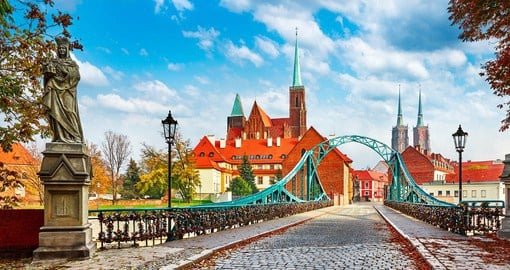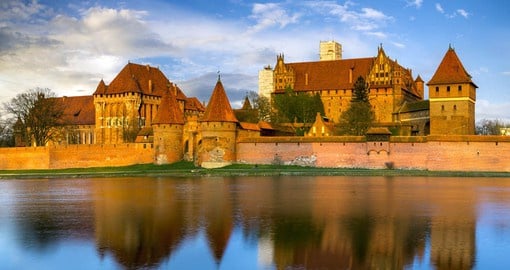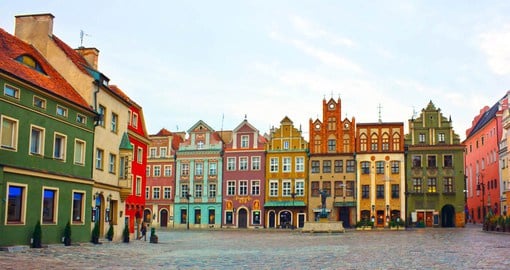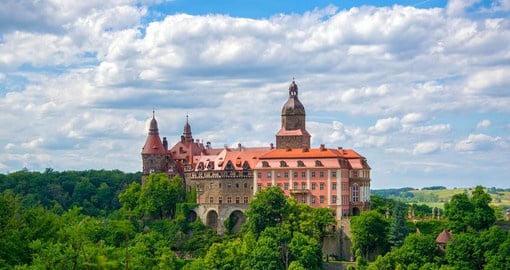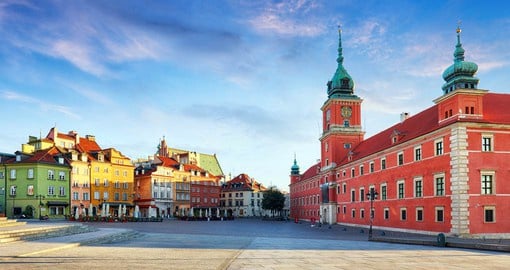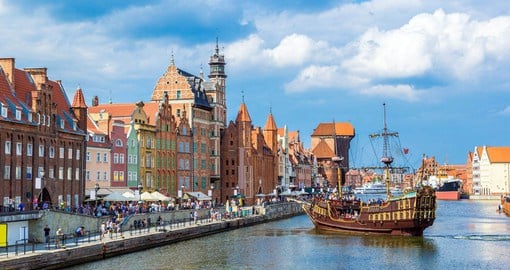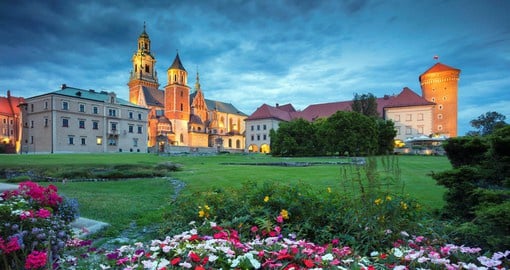Best of Poland: Warsaw, Gdansk, Wroclaw & More
- Duration
- 13 Days
- Prices From:
- US$ 3,747
FIRST-CLASS | PRIVATE-GUIDED: Embark on an expansive, privately-guided tour of Poland and delve into the country’s past and lively present. This tour includes the best of Warsaw and Krakow, and then goes beyond, bringing you to other Polish gems including Gdansk, Poznan, and Wroclaw.
This 13-day Polish vacation takes you throughout the country to Warsaw, Gdansk, Poznan, Wroclaw, and Krakow. It features first-class accommodations and private tours.
Your journey begins in the Polish capital, Warsaw, a city rebuilt from the ashes of World War II. Head on a private city tour to learn about the city’s history and its reconstruction over the years. Start at the brutalist Palace of Culture and Science, a holdover of the Soviet past, before reaching the medieval Old Town and the Royal Castle. While in Warsaw, you’ll also learn about the life of classical composer Frederic Chopin, who was born in Poland. Head to the Church of the Holy Cross, where his heart is entombed, and visit the Chopin Monument at Royal Lazienki Park before ending the tour at the Chopin Museum to examine his letters, drawings, and personal piano.
From Warsaw, connect by train to Gdansk, which sits on the Baltic Sea and used to be the country’s main trade port during the era of the Hanseatic League. A private walking tour will delve into the history of the city, which is also known as Danzig in German, taking you past the Crane Gate, the last remains of the Old Harbor, to Srodmiescie District, where you’ll see medieval holdovers and charming boutiques, and finally St. Mary’s Church, a massive brick structure that can accommodate 20,000 people. While based in Gdansk, you’ll also learn about Poland’s medieval past at Malbork Castle, a Teutonic fortification that was painstakingly rebuilt following damage in World War II.
Continue on to Poznan, which is one of the oldest cities in the country and the celebrated birthplace of Poland. You’ll learn about this medieval gem on a private city tour that takes you through the Old Town to admire 16th-century merchant row houses, great Polish paintings at the National Museum, and the Imperial Castle, which was constructed by Germans during Prussian control. End your tour on Ostrow Tumski, located on the forks of the Warta River, where Mieszko I, the founder of Poland, is buried. Ride the train to Wroclaw and explore arguably the most beautiful city in Poland and its Catholic centrepiece. Stroll down Katedralna, an enchanting street lit by gas lamps, see the religious monuments of the Gothic St. John the Baptist Cathedral and Holy Cross Church, and end your tour in medieval Market Square and Plac Solny, where flower stalls sell colourful bouquets 24 hours a day. Based in Wroclaw, you’ll also head on a tour into the Owl Mountains to visit Ksiaz Castle, the country’s third-largest castle, which overlooks the Pelcznica River from a high cliff. Connect by train to your final destination, Krakow, the nation’s most popular city. Centre on one of the largest medieval town squares in Europe, Krakow delights with its medieval architecture, lively restaurant scene, and easy access to historical attractions. A city tour will take you through the medieval core on a journey from the Market Square up Wawel Hill to Wawel Castle. Another day, pay your respects and learn about the horrors of the Holocaust on a visit to the Auschwitz-Birkenau Concentration Camp, located in the nearby town of Oswiecim. On your final day in Poland, head to Wieliczka Salt Mine, which was the oldest operating salt mine in Europe until it ceased operations in 1996. Explore it subterranean corridors and admire its unique sights, from the massive timber pillars that buttress the main cavern to St. Kinga’s Chapel, which is entirely carved from the salt. At the end of your tour, head to the airport to connect back home.
- Duration
- 13 Days
- Prices From:
- US$ 3,747
Itinerary View Trip Map
Warsaw Airport to Warsaw Hotel
| Duration | 20 Minutes |
|---|
Polonia Palace Hotel
Polonia Palace Hotel offers several accommodation options, which include a choice of rooms, suites and an exclusive English Apartment featuring a unique view of Warsaw and modern amenities.
Polonia Palace rooms are the perfect blend of luxury and comfort. After a day of work or leisure in the Polish capital, treat yourself in the carefully designed and furnished rooms and suites of Polonia Palace Hotel in Warsaw.
| Meal Plan | Buffet Breakfast |
|---|---|
| Duration | 3 Nights |
| Accommodation |
Polonia Palace Hotel |
| Location | View map |
-
Polonia Palace Hotel
Polonia Palace Hotel offers several accommodation options, which include a choice of rooms, suites and an exclusive English Apartment featuring a unique view of Warsaw and modern amenities. Polonia Palace rooms are the perfect blend of luxury and comfort. After a day of work or …
Polonia Palace Hotel offers several accommodation options, which include a choice of rooms, suites and an exclusive English Apartment featuring a unique view of Warsaw and modern amenities.
Polonia Palace rooms are the perfect blend of luxury and comfort. After a day of work or leisure in the Polish capital, treat yourself in the carefully designed and furnished rooms and suites of Polonia Palace Hotel in Warsaw.Facilities
- Bar
- Lobby
- Meeting Rooms
- Restaurant
Photo gallery
Photo 1 of 3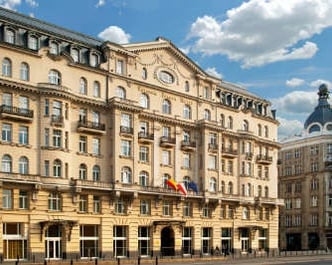
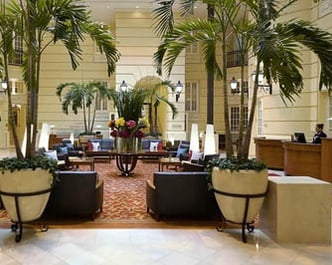
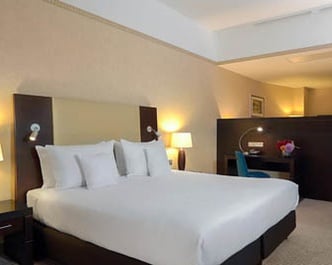
City Tour with Royal Castle
Enjoy an enlightening, privately guided tour of Warsaw, Poland's capital and the country's commercial center. A city with a stormy history, it felt the touch of Napoleon who officially created the Duchy of Warsaw on his way to Moscow, lived through national uprisings and tsarist repressions, and barely survived the Second World War. All these events left their individual imprints on the city. This includes the towering Palace of Culture and Science, a Stalinist behemoth built by Soviet architect Lev Rudnev, and a stark reminder of Warsaw's days under communist rule. Today, it is occupied by rather more sociable institutions such as two museums, a university, four theatres, a multiplex cinema, and a swimming pool. The city's Old Town, dating back to the 13th century, was almost entirely destroyed during WWII but has been meticulously reconstructed and is on the UNESCO World Heritage List. Here, everywhere you go, are evocations of Warsaw's tempestuous past, as much as its reconstruction. Without abandoning its past, today's Old Town has also ushered in an exciting new era. It's a bustling hub with cobblestone alleys and medieval buildings, at the heart of which is the Old Town Market Place, a busy square lined with burgher houses, boutiques, bars, and upscale Polish eateries. Nearby, St. John's Arch cathedral dates to the 14th century and hosts all kinds of concerts during the summer while next to the manicured gardens of the Royal Castle, there are now many restored contemporary apartment buildings. The city's contemporary, creative and even quirky side has, quite naturally, led to the development of trendy neighborhoods, of which Praga, across from the historic center on the other side of the Vistula is, probably, the most popular. On a more curious note, outside some of downtown's subway stations and next to pedestrian crossings, street-sellers have established a thriving business selling, guess what, doughnuts. Your private guide can elaborate on many of the historical and current topics. One of the most fascinating stories is how Varsovians, the name for residents of Warsaw, reconstructed their city. Partially this was done based on cityscapes by the Venetian painter Bernardo Belloto, the nephew of the more famous Canaletto. Belloto had been appointed a court painter to the King of Poland and created very accurate scenes of Warsaw's buildings and squares in 1768. Since 1984 they have been exhibited in the Royal Castle's Canaletto room, which you will visit during your tour. During today's sightseeing, you'll also see the famous site of a row of buildings, cut in half by the war, near the former ghetto and the Presidential Palace where the Warsaw Pact was signed in 1955. The drive along the Royal Route culminates with a visit of the Royal Castle, once the residence of the Polish kings, seat of the Senate and the place where the Polish Constitution was signed.
| Duration | 4 Hours |
|---|
Chopin City Tour
Enjoy a privately guided tour through the Warsaw of Fryderyk Chopin, one of the Polish capital's most famous sons, and a composer and virtuoso pianist of worldwide renown. People unfamiliar with the Polish variant of his first name might more easily recognize him as Frederic Francois Chopin. On this tour, you are going to see some of the city highlights associated with the composer and spend a good deal of time in the Fryderyk Chopin Museum. One of the key spots is the Church of the Holy Cross, located on the Royal Route, the main road out of the Old Town. On a small ornamental plaque, written in both Polish and English, are the words "Here rests the heart of Frederic Chopin." In fact, it does! Although the composer lies buried in Paris, he requested that his heart be sent back to his home country, knowing that his body would never leave the French capital. His eldest sister, Ludwika Jedrzejewicz, complied by taking the heart before his body was buried and smuggled it back to Poland in a jar of booze, presumably cognac, where it was buried beneath a small monument at the Holy Cross Church in Warsaw. In 2014 a secret number of church officials, scientists, and medical experts dug up the heart under cover of night to check the container preserving the heart, for fear it might have cracked. The good news is that it is still in great condition. His musical legacy is very much alive with Chopin concerts being held throughout the summer in Royal Lazienki Park. The Chopin monument was erected here to commemorate the virtuoso and is the only example of Art Nouveau monument architecture in Warsaw. The concerts have been held in its shadow since 1959. Another place of note is Czapski Palace, a popular meeting point for the city's elite, where Chopin spent his last years before permanently leaving the country in 1830. Two of his most important works during his Warsaw period were composed here. The impressive Visitationists Church is another Chopin highlight because this is where young Fryderyk, often, played the organ during mass for pupils from the Warsaw Lyceum, which he attended. His museum, located in the historic Ostrogski Palace, adds a final flourish to your Chopin exploration. The well-curated exhibits and multimedia displays tell the story of his life spent in Warsaw and after he emigrated. The priceless memorabilia include letters, drawings, his hand casting, and death mask, and a priceless Pleyel piano on which the composer played for the last two years of his life. In the room dedicated to his affair with French novelist George Sand, you will hear the song of birds from Nohant, a village where the couple spent their summer days. The museum allows you to further delve into the creative process of the artist by looking at his musical sketches, notes, and manuscripts of finished works, all in an interactive format. This is an excellent tour for couples of all ages, introducing selected parts of Warsaw through the life of Chopin.
| Duration | 4 Hours |
|---|
Warsaw Hotel to Warsaw Train Station
| Duration | 10 Minutes |
|---|
Gdansk Train Station to Gdansk Hotel
| Duration | 10 Minutes |
|---|
Hotel IBB Dlugi Targ
You'll be in a fantastic location at IBB Hotel Dlugi Targ, just a 5-minute walk from Neptune's Fountain and Artus Court. For a bite to eat, guests can check out Restauracja 5. Pietro, which serves international cuisine and is open for breakfast, lunch, and dinner. Rooms at this upscale hotel offer 24-hour room service, TVs, and minibars. This is a great selection for travellers that want to be in the very heart of Gdansk.
| Meal Plan | Buffet Breakfast |
|---|---|
| Duration | 2 Nights |
| Accommodation |
Hotel IBB Dlugi Targ |
| Location | View map |
-
Hotel IBB Dlugi Targ
You'll be in a fantastic location at IBB Hotel Dlugi Targ, just a 5-minute walk from Neptune's Fountain and Artus Court. For a bite to eat, guests can check out Restauracja 5. Pietro, which serves international cuisine and is open for breakfast, lunch, and dinner. …
You'll be in a fantastic location at IBB Hotel Dlugi Targ, just a 5-minute walk from Neptune's Fountain and Artus Court. For a bite to eat, guests can check out Restauracja 5. Pietro, which serves international cuisine and is open for breakfast, lunch, and dinner. Rooms at this upscale hotel offer 24-hour room service, TVs, and minibars. This is a great selection for travellers that want to be in the very heart of Gdansk.
Facilities
- Massage Treatments
- Meeting Room
- Restaurant
- Spa
Photo gallery
Photo 1 of 1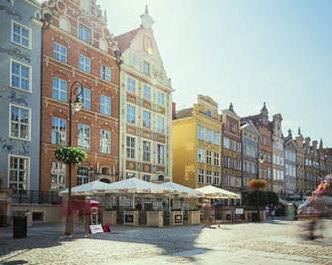
Walking Tour of Gdansk
Enjoy a privately guided, half-day walking tour starting from your hotel where you'll meet your guide. Gdansk has a unique feel. It's a cultured, wealthy, cosmopolitan city with an incredibly rich history that sets it apart from most other cities in Poland. A strategic port for nearly a thousand years, Gdansk was a stronghold of the Teutonic Knights and, during the Middle Ages, became an influential city within the Hanseatic League. WWII started on its doorstep and it was largely destroyed during the conflict but, miraculously, rebuilt into one of Europe's most beautiful port cities. Little is left of the city's original trading age, except Crane Gate located in the old harbor, which has become one of the defining symbols of Gdansk. Admire the structure, created between 1442-1444, that was, at one time, the biggest working crane in the world. Most of Gdansk's main attractions are, however, conveniently confined to the Srodmiescie district, the city's central quarter, divided into the Main and Old Town. One of the city's key attractions is Long Lane, with Golden Gate on one end and Green Gate on the other, lined with restaurants, cafes, boutiques, and shops. Sandwiched in between is Dlugi Targ, the Long Market, once home to the city's elite and a beautiful area with gorgeous architecture. Its focal point is the lovely Neptune Fountain. Close by is Artus Court, originally a meeting place for merchants and dignitaries named after King Arthur of round table fame and the 14th century Main Town Hall, with a tower that affords spectacular views over the city and is equipped with a carillon, 37 bells of which are still intact. As you well know, a carillon is a musical instrument that is typically housed in the bell tower of a church or municipal building. St. Mary's Church, supposedly the largest brick church in the world and able to accommodate almost 20,000 people, is thought by many to be the city's most amazing attraction. It's not just the sheer size of the place but also the astronomical clock kept inside, which was built in the 1400s by famous clockmaker Hans Duringer. The elaborate clock is made almost entirely of wood and, standing over 45 feet tall, it might be the tallest wooden clock in the world. Depending on time, you might have a chance to walk past the Shakespeare Theatre, commemorating the historical legacy of Shakespeare in Gdansk, whose plays were regularly performed in the city during the early 1600s.
| Duration | 4 Hours |
|---|
Tour to Malbork Castle
If history is your thing, especially when it involves knights and castles, then this privately guided excursion to Malbork Castle is a great choice. Your guide will pick you up from your hotel and it is an easy 60 km to the small town of Malbork, to the southwest of Gdansk. Malbork Castle is, without question, one of the most impressive sights in Poland and during its long history, it changed hands many times. It was built in 1274 by an order of the Teutonic Knights, in what was then part of Prussia, and named Marienburg after the Virgin Mary, the patron saint of the Order. Its headquarters were originally in Acre (in today's northwest Israel) but when this last stronghold of the Crusades fell, the Grand Master moved the Order to Venice and in 1309 to today's Malbork. The castle was expanded several times to host the growing number of Knights and became the largest fortified Gothic building in Europe. Different wars brought turmoil and a revolving door of 'owners'. Polish kings held sway from 1457-1772, twice interrupted by the Swedes in 1626 and again in 1656, each time for a few years. The Prussians occupied it in 1772, curiously letting it fall into complete disrepair until German architect Conrad Steinbrecht completed an extraordinary reconstruction between 1882-1921. Finally, in 1945 the castle was turned into a place of last resistance by German forces fighting the Red Army, which led to the complete devastation of the eastern part of the upper and middle castle, the main tower and the castle's church. A major reconstruction effort by the Polish authorities began after the war that led to Malbork Castle earning a UNESCO World Heritage Site designation in 1997 and being named one of Poland's official historic monuments. Castle enthusiasts will be in their element. While the exterior of the three castle buildings, encircled by strong defensive walls with huge gates and mighty towers, is a breathtaking sight, your tour through interior spaces is equally impressive. The Great Refectory, where the Grand Masters entertained guests, is fascinating and be sure to look up to admire the three tree-like pillars, branching up to a stunning vaulted ceiling. The castle's kitchen, chapel, dormitory, stately halls, and the sentinel points on the battlements are all areas that demonstrate the sheer size of the place. Apart from its fine Gothic design details, the castle contains a collection of amber jewelry, artifacts, porcelain, sculptures, coins and weapons of historic value.
| Duration | 7 Hours |
|---|
Gdansk Hotel to Gdansk Train Station
| Duration | 10 Minutes |
|---|
Poznan Train Station to Poznan Hotels - Private
| Duration | 5 Minutes |
|---|
Hotel Altus
Hotel Altus Poznan is a three-star hotel located in one of the most distinctive buildings in Poznan, providing an ideal mix of value, comfort, and convenience. Most of Poznan's local landmarks are nearby, including the National Museum and Parish Church of St. Stanislaus, the Old Market Square, and the Croissant Museum. The rooms are air-conditioned and have all the necessary amenities while being moderately priced.
| Meal Plan | Buffet Breakfast |
|---|---|
| Duration | 1 Night |
| Accommodation |
Hotel Altus |
| Location | View map |
-
Hotel Altus
Hotel Altus Poznan is a three-star hotel located in one of the most distinctive buildings in Poznan, providing an ideal mix of value, comfort, and convenience. Most of Poznan's local landmarks are nearby, including the National Museum and Parish Church of St. Stanislaus, the Old …
Hotel Altus Poznan is a three-star hotel located in one of the most distinctive buildings in Poznan, providing an ideal mix of value, comfort, and convenience. Most of Poznan's local landmarks are nearby, including the National Museum and Parish Church of St. Stanislaus, the Old Market Square, and the Croissant Museum. The rooms are air-conditioned and have all the necessary amenities while being moderately priced.
Facilities
- Conference Room
- Fitness Room
- Free WiFi
- Lobby Bar
- Restaurant
Photo gallery
Photo 1 of 1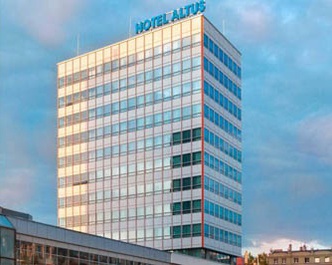
City Tour of Poznan
Still under the tourist radar, Poznan surprises with delightful cafes in hidden courtyards, a wonderful artistic vibe and a positive buzz at almost any time of day. Quite befitting for the 1000-year-old birthplace of Poland, it also offers several marvelous historical attractions. The city is just the right size to explore and you can discover much of this during a privately guided tour after your guide picks you up from your hotel. A brief historical side note, Poznan is where Catholicism first gained a foothold on Polish soil in the 10th century by the nation's first ruler, Mieszko I, who died in Poznan in 992 AD and is buried in the city's cathedral. Enjoy Poznan's Old Town, centered around the Old Market Square with one of the finest town halls you'll ever see. One of its towers features two small billy goats which butt their heads together every day at noon. Next to the majestic town hall is a row of 16th-century merchants' houses and as you continue, watch out for the medieval pillory and the fountains depicting Proserpina, Apollo, Neptune and Mars. Just off the Market Square is the glorious facade of the church of St. Stanislaus, one of Poland's finest religious Baroque buildings, and boasting 13 altars. The National Museum has one of Poland's largest collections of foreign art, as well as the crop of Polish paintings from the 1500s to the 1900s. Some of the masters featured in the gallery are Lucas Cranach the Elder, Anthony van Dyck, Bellini, Velazquez, Tintoretto and Monet. The former Universal Department Store commonly referred to as the 'Round Building' or Okraglak, is an example of modernist architecture and the very first building in Poznan constructed out of prefabricated materials. It is considered one of the city's most important edifices even though it was built in an era pervaded by socialist realism. Meanwhile, St Marcin Street, famous for its croissants, is a main central street that runs from the Old Town to Poznan's Imperial Castle, also known as the Zamek, which was constructed for William II, the German Emperor, in 1910 when the city was under German rule. It's not far-fetched to say that Poland was born on Ostrow Tumski, the Cathedral Island, located between the forks of the Warta River and today a sleepy settlement of cobblestone streets within a profusion of greenery and squares fringed by fruit trees and ecclesiastical buildings. This is where you'll also find Poznan Cathedral, Poland's oldest, and burial place of Poland's first ruler and founder of the cathedral, Mieszko I.
| Duration | 4 Hours |
|---|
Poznan Hotels to Poznan Train Station - Private
| Duration | 5 Minutes |
|---|
Wroclaw Train Station to Wroclaw Hotel - Private
| Duration | 10 Minutes |
|---|
Art Hotel Wroclaw
Art Hotel is located only 657 feet from the Wroclaw Main Market Square and one kilometre from the Ostrow Tumski. It features air-conditioned rooms with free Wi-Fi and satellite TV.
All elegant rooms at Art have private bathrooms with high quality cosmetics and a hairdryer. Each room is fitted with a minibar and a work desk.
A varied buffet breakfast is served every morning in the Art Restaurant, a hotel restaurant and cafe, which specializes in Polish and Italian dishes. Special diet menus, including gluten free and diabetic, are available on request.
Front desk staff is available 24 hours a day and can provide guests with laundry, ironing and dry cleaning services.
Art Hotel is housed in 2 historic connected buildings, one of which is from the 16th century. The elegant hotel interiors combine Renaissance and New Gothic style.
| Meal Plan | Buffet Breakfast |
|---|---|
| Duration | 2 Nights |
| Accommodation |
Art Hotel Wroclaw |
| Location | View map |
-
Art Hotel Wroclaw
Art Hotel is located only 657 feet from the Wroclaw Main Market Square and one kilometre from the Ostrow Tumski. It features air-conditioned rooms with free Wi-Fi and satellite TV. All elegant rooms at Art have private bathrooms with high quality cosmetics and a hairdryer. …
Art Hotel is located only 657 feet from the Wroclaw Main Market Square and one kilometre from the Ostrow Tumski. It features air-conditioned rooms with free Wi-Fi and satellite TV.
All elegant rooms at Art have private bathrooms with high quality cosmetics and a hairdryer. Each room is fitted with a minibar and a work desk.
A varied buffet breakfast is served every morning in the Art Restaurant, a hotel restaurant and cafe, which specializes in Polish and Italian dishes. Special diet menus, including gluten free and diabetic, are available on request.
Front desk staff is available 24 hours a day and can provide guests with laundry, ironing and dry cleaning services.
Art Hotel is housed in 2 historic connected buildings, one of which is from the 16th century. The elegant hotel interiors combine Renaissance and New Gothic style.Facilities
- 24 Hour Room Service
- Business Centre
- Cafe
- Conference Facilities
- Fitness Rooms
- Garden
- Internet Access
- Laundry Service
- Luggage Storage
- Restaurant
- Safety Deposit Box
- Shoeshine
- Undercover parking
Photo gallery
Photo 1 of 1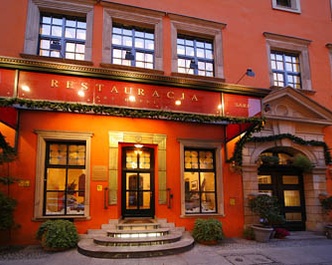
City Tour of Wroclaw
Wroclaw is one of the oldest and most beautiful cities in Poland, and you can enjoy discovering most of its highlights on this privately guided tour after you meet your driver-guide in the lobby of your hotel. Your tour begins with Ostrow Tumski, in many ways the gem at the center of Wroclaw's crown. This is the city's historically most significant part, closely tied to Catholicism, hence the remarkable concentration of religious buildings and, as you will see, an incredibly peaceful place to explore. Ostrow Tumski's real joy is its slightly otherworldly feel. Katedralna, one of its particularly gorgeous streets, for example, is still lit by original gas lamps today; perfect for a romantic evening stroll. The architecture around here is fantastic. Among the most delightful edifices are the Gothic St. John the Baptist Cathedral, the Holy Cross Church, the Archdiocese Museum and the Russian Orthodox Church of Saints Cyril and Methodius. Moving away from Ostrow Tumski, you continue to the magnificent baroque Aula Leopoldina, a beautiful Baroque Hall on the first floor of the main University building. It was named after the Austrian Emperor Leopold who founded the university in 1702.
Your next stop is going to be an amazing sensory experience. During its history, Poland has been subject to Russian dominance multiple times, and a visit to the Raclawice Panorama introduces you to an extraordinary painting that depicts a historical piece of Polish bravery that is now enshrined as a national legend. 375 feet around and 50 feet high, the 360-degree cyclorama depicts a peasant army, led by General Tadeusz Kosciuszko, wielding scythes and rushing the ranks of Russian hussars in a heroic bid for independence. The special lighting inside the cyclorama, together with clever shading techniques, allows visitors to relive the famous battle as it swirls around them in a fashion that feels incredibly real. The painting itself, encircling the massive building, captures the chaos and heroism and will, probably, leave visitors with a deep impression.
Wroclaw also boasts many green spaces, such as the Old Town Promenade in the city center and more than 14 parks and gardens further in. Meanwhile, the large Market Square, after a thorough renovation in 1997, is, without doubt, the most beautiful in Poland, if not in Europe. Clearly, this is the heart of the city, but you need to remember that most of the buildings are replicas of those that stood there before the war. The history of the square dates to the 13th century and most of what you see now was originally laid out by city planners back in 1241. As you walk around the square, you're going to be struck by Wroclaw's fabulous Town Hall. It seems to be patched together from bits and pieces of a dozen different buildings, the result of a construction period that lasted about 250 years, embracing many political and artistic changes. Up until the early 20th century, city life was centered around it, housing the Town Council, merchants' stalls and, crucially, a beer cellar. Adjacent to the main square you'll find, Plac Solny, its little flower-loving sibling, that was built most likely in 1242, following another disastrous invasion, but not by the usual culprits. Instead, it was the Mongols this time. Today Plac Solny is known for numerous 24-hour flower stalls, which turn it into a phantasmagoria of colors night and day. The entire Market Square area is, of course, a very lively place with lots of restaurants, bars, pubs, cafes and numerous shops, all framed by those beautifully colored facades of the restored buildings.
| Duration | 4 Hours |
|---|
Ksiaz Castle Tour
Enjoy a privately guided trip to the Owl Mountains of Southwestern Poland to visit Ksiaz Castle, Poland's third-largest castle with a history that is shrouded in mystery to this day. Starting with your driver-guide picking you up from your hotel, it's a 70 km drive to the city of Walbrzych and Ksiaz Castle. Also known by its German name, Schloss Furstenstein, it's an imposing edifice sitting atop a majestic rock cliff by the side of the Pelcznica River, at a height of 1,300 ft above sea level. Its origins can be traced back to the 13th century, but it has been destroyed and rebuilt at various times. In the process it was also re-designed and expanded using different styles, ranging from Baroque to neo-Classical, with the occasional nod to Gothic. The von Hochberg, one of the richest and most influential families in Prussia, lived here for many generations from the 16th century onwards when Konrad von Hochberg was granted the rights to the castle and the surrounding area. It was confiscated by the Nazis in 1941 and stripped of much of the interior furniture as it became part of the 'Riese Project', a secret plan to create a hidden, underground, military complex with an intricate array of tunnels and subterranean roads, rail links, and factories. Tens of thousands of Nazi prisoners, mainly Jews from Hungary and Poland, were forced to build this massive facility with 12-meter high ceilings beneath the Gothic and Baroque ramparts rising from the castle above, which was rumored to become the new headquarters for Adolf Hitler. With the Red Army approaching fast at the end of the war, the Nazis destroyed large portions of the complex. The exact plans of the Riese objective remain a mystery and the Red Army destroyed or secreted away any information relevant to the project. Rumors of train wagons full of Nazi gold created moments of an Eastern European Klondike, with people trying their luck searching the surrounding forests. Visitors to the castle, on the other hand, can admire many of the rooms built under the stewardship of Konrad Maximilian von Hochberg in the 18th century, all of which have been lovingly restored. Among them are the great Maximilian Room, the Summer Pavilion, the beautiful Games Salon and the China Salon. One room has been turned into a wondrous antique store but a walk around the gardens and terraces that surround the castle is the best way to truly appreciate the various architectural styles. Apart from the marvelous interior and public spaces of the castle, you can still visit a small section of the underground tunnels that are open to the public or walk along the castle's ramparts and terraces, offering gorgeous views on the beautifully landscaped gardens, and the lushly dense forests beyond. This is a great excursion for travelers of all ages, especially those interested in history with an air of mystery and intrigue.
| Duration | 6 Hours |
|---|
Wroclaw Hotel to Wroclaw Train Station - Private
| Duration | 10 Minutes |
|---|
Krakow Train Station to Krakow Hotel
| Duration | 15 Minutes |
|---|
Metropolitan Boutique Hotel Krakow
Metropolitan Boutique Hotel invites you to the heart of Cracow - Polish cultural capital and a city full of life. The hotel is established in a newly renovated 19th century building, perfectly placed between the Old Town Square and the trendy area of Kazimierz. It is ideally located away from the noise, yet only minutes walk from the city's main attractions. The fusion of traditional architecture with modern and elegant interiors, combined with a great location and perfect service will make for a memorable stay in Cracow.
| Meal Plan | Full Breakfast |
|---|---|
| Duration | 4 Nights |
| Accommodation |
Metropolitan Boutique Hotel Krakow |
| Location | View map |
-
Metropolitan Boutique Hotel Krakow
Metropolitan Boutique Hotel invites you to the heart of Cracow - Polish cultural capital and a city full of life. The hotel is established in a newly renovated 19th century building, perfectly placed between the Old Town Square and the trendy area of Kazimierz. It …
Metropolitan Boutique Hotel invites you to the heart of Cracow - Polish cultural capital and a city full of life. The hotel is established in a newly renovated 19th century building, perfectly placed between the Old Town Square and the trendy area of Kazimierz. It is ideally located away from the noise, yet only minutes walk from the city's main attractions. The fusion of traditional architecture with modern and elegant interiors, combined with a great location and perfect service will make for a memorable stay in Cracow.
Photo gallery
Photo 1 of 1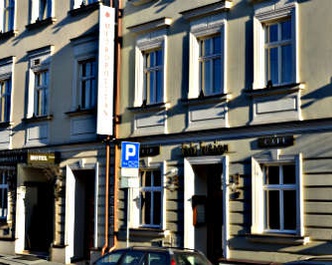
City Tour with Wawel Castle
Poland's former capital is, beyond question, one of the most beautiful cities in Europe. On this privately guided tour, you'll experience many of its highlights after meeting your guide in the lobby of your hotel. A UNESCO World Heritage site since 1978, it is often compared to other medieval Central European cities but has always had a flair uniquely its own, combining a little bit of Gothic, Renaissance and Baroque styles. While avoiding the almost total destruction of Warsaw, it still suffered greatly during WWII and the post-war communist regime tried its best to eradicate the soul of the city which they considered middle-class and a hotbed for intellectuals. In the end, communist neglect protected it from modernity, allowing a revitalization effort which created a young city that regained its vibrant colors. Today's Krakowians are proud of their city, its heritage as well as its intellectual and artistic life, cultivating a wonderful nonchalance that some compare to an almost Viennese spirit.
On this half-day excursion, you'll start at the Market Square, one of the biggest in Europe, and a reminder of the power and wealth of medieval Krakow. With houses displaying Renaissance and Baroque facades, the famous Cloth Hall and oodles of pavement cafes, the Rynek, as it is known, is one of the most beautiful squares in Europe. Close by, it's the towering edifice of St. Mary's Cathedral - originally built in the early 13th Century - that awaits your visit. The exterior is impressive for sure, but the interior is, possibly, the most amazing you have ever seen. Virtually every square inch is ornately decorated, painted, carved, frescoed, or otherwise covered in the most fabulous colors imaginable, the piece de resistance being the 15th-century altar. Krakow's multicultural heritage and huge student population make it a vibrant city all year round, its Jagiellonian University, a research institution founded in 1364 by Casimir III the Great, is the second oldest university in Central Europe, and one of the oldest surviving universities in the world.
On your way to reach Wawel Hill, you'll pass the Planty, a vast leafy promenade that surrounds the historic center on the site of the city's old ramparts. Crowned by its royal castle and cathedral, Wawel is the crucible of Polish identity and a place that is highly symbolic since it was used for the coronation of kings. Built on the remains of a 10th-century settlement it features magnificent Renaissance interior spaces together with the famous Wawel Tapestries, considered by art historians to be a priceless and unparalleled collection of woven artworks. An important part of the historic structure is the Cathedral and you'll have a chance to see the Royal Chambers, the underground necropolis with tombs and sarcophagi, as well as the famous bell tower. The Royal Sigismund Bell is the largest of the five bells hanging in the Wawel Cathedral, named after its patron, Sigismund I, King of Poland and Grand Duke of Lithuania, who commissioned it. It weighs 13 tons!
Finally, at the end of your tour, you'll come down to the Vistula River where you can admire the statue of a fearsome dragon from Polish folklore, not exactly well known around the world. Let your guide tell the story about Smok, the Wawel dragon.
| Duration | 4 Hours |
|---|
Tour to Auschwitz-Birkenau Concentration Camp
Krakow is a beautiful city with a population that is characterized by its youth and dynamism, looking back on an illustrious past as a cultural center, bringing back its rich and artful facades that have recovered their pastel shades. Nevertheless, for those that choose to make the journey, the proximity of Auschwitz-Birkenau, 75 km away, is not only a stark reminder of horrific events in the recent past but also adds a profound sense of a raw and terrifying history that is difficult to confront emotionally or intellectually. On this privately guided tour, the struggle many travelers have with the question as to whether it is right to visit may not be fully answered to everyone's satisfaction. The, perhaps, most important point to remember is that those who survived the camps or saw family, friends or neighbors perish, were unwavering in their determination to ensure that Auschwitz should be preserved as a memorial for future generations. Many of the images will be haunting and, yes, nobody returns from this tour unaffected. It is, however, also true that the majority do not regret having done it. The area is well preserved and houses the Auschwitz-Birkenau Memorial and Museum, which is listed as a UNESCO World Heritage site, originally constructed in the suburbs of the Polish city of Oswiecim, later renamed to Auschwitz. The first and oldest part of the camp became known as Auschwitz I, established on the grounds of prewar Polish barracks, where the number of prisoners fluctuated between 15,000 and 20,000. The second installation was the Birkenau camp, also known as Auschwitz II, the largest part of the Auschwitz complex, where over 90,000 prisoners were held in 1944. Your tour includes a visit to the brick-mortar barracks in Auschwitz I, and the extensive area of the large wooden buildings of the extermination camp at Auschwitz II - Birkenau. Please note that your driver-guide will only provide the private return transfers, and explanations about the history prior to entering the site. Due to local regulations, once inside Auschwitz -Birkenau, you will be joining a shared group tour led by an officially licensed local guide. This tour is not suitable for children under 14.
| Duration | 6 Hours |
|---|
Tour to the Wieliczka Salt Mine
Over one million people travel to the small town of Wieliczka, just 25 minutes outside Krakow, every year to, voluntarily, go underground. Well, just for a couple of hours. You can find out why during this tour to the Wieliczka Salt Mine. Meet your English-speaking driver in the lobby of your hotel for the short, private transfer to the mine, however, please note that the actual tour of the mine is a shared experience led by a local Wieliczka guide. The mine is thought to have been operating since the 13th century, making it the oldest salt mine in the world that was still operating, until a few years ago. While commercial salt mining ended in 1996, small-scale mining of salt continued until 2007. Included in the UNESCO World Cultural and Natural Heritage List in 1978, it is an amazing experience. For over 700 years Polish miners hewed rock and hollowed out space, creating over the centuries a labyrinth that extends across 287 kilometers underneath the Polish countryside. That is, however, not the reason it attracts such huge numbers of visitors which, by the way, has included such notables as Nicolaus Copernicus, Johann Wolfgang von Goethe, Alexander von Humboldt, Fryderyk Chopin, Robert Baden-Powell, former U.S. President Bill Clinton, Pope John Paul II and many others. Aside from mining salt, generations of miners also carved Baroque sculptures and entire chapels from the softly glowing walls of their subterranean workplace. The result is a fantastic underground world, full of cavernous spaces and winding passages, some of which are works of great intricacy, while others appear roughly hacked. Your journey begins with a descent down the Danilowicz Shaft to Level I of the mine. It is situated 64 meters underground, which means you'll have to walk down 380 stairs. The next levels lead you down even deeper, to a level of about 135 meters. Your tour includes the Tourist Route, located on the first three levels of the mine and the Museum Route, located entirely on Level III. Sightseeing of the 2-kilometer long Tourist Trail takes about 1.5 hours, while the Museum version is a slightly shorter 1.5 kilometers. Since you'll be walking something like 3.5 km and negotiate, altogether, 800 steps along the whole route, make sure to wear comfortable shoes. Please remember too that it is quite cool in the mine (between 17 and 18 degrees Celsius) and you should consider taking warmer clothing even in summer. What unfolds in front of you, once you enter the mine, ranges from the fantastic to the enchanting. In parts, it's like a small town with a restaurant, post office, cinema, and theater hall. The miners slowly turned the mine from a dark cave into a majestic, royal location and by the 19th-century giant salt-crystal chandeliers illuminated the underground complex. Prepare to be dazzled by salt sculptures, tree bridges, crystal grottoes, chapels and altars, underground ponds and many more magic details along the way. On the Museum Route portion, highlights include the world's largest wooden mining machine, called the 'Polish' and several monumental and beautiful chambers, including the Maria Teresa Chamber. Leaving the mine is facilitated by a brief, but rapid, an ascent in an authentic miners' elevator. This is a fabulous excursion for reasonably fit travelers of all ages, including families.
| Duration | 4 Hours |
|---|
Krakow Hotel to Krakow Airport
| Duration | 30 Minutes |
|---|
Other Information
DEPARTURES:
Daily
PRICE INCLUDES:
- Private arrival and departure airport transfers
- 3 nights in first-class accommodations in Warsaw
- 2 nights in first-class accommodations in Gdansk
- 1 night in moderate accommodations in Poznan
- 2 nights in first-class accommodations in Wroclaw
- 3 nights in first-class accommodations in Krakow
- Private-guided Warsaw city tour with visit to the Royal Castle
- Private-guided Frederic Chopin tour in Warsaw
- Private train station transfers in Warsaw and Gdansk
- Private-guided walking tour of Gdansk
- Private-guided tour to Malbork Castle
- Private train station transfers in Gdansk and Poznan
- Private-guided Poznan city tour
- Private train station transfers in Poznan and Wroclaw
- Private-guided Wroclaw city tour
- Private-guided tour to Ksiaz Castle
- Private train station transfers in Wroclaw and Krakow
- Private-guided Krakow city tour with visit to Wawel Castle
- Private-guided tour to Auschwitz-Birkenau Concentration Camp
- Private-guided Wieliczka Salt Mine tour
- Breakfast daily (excluding Day One)
PRICE EXCLUDES:
- Travel insurance
- International and domestic airfare & airfare taxes
- Rail tickets
- Meals and beverages not explicitly listed as included
- Entrance fees not explicitly listed as included
- Gratuities
- Items of a personal nature
- Visa fees if applicable
TERMS AND CONDITIONS:
Prices are "from" per person based on twin/double shared accommodation and for travel in low season. Seasonal surcharges and blackout dates may apply. Limited seat/spaces and all pricing is subject to change and availability. Rates for single or triple travellers are available on request - please inquire.
20 Nov 2023






